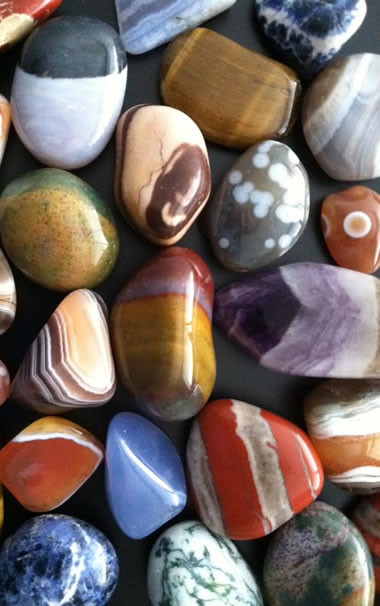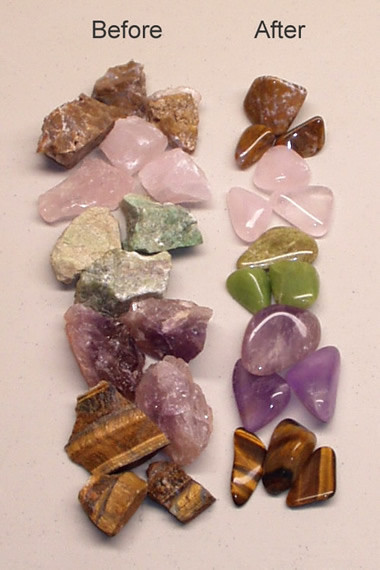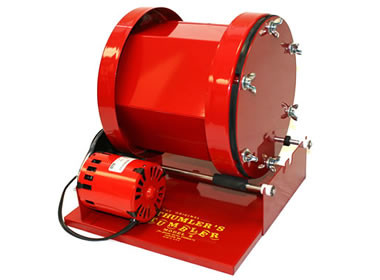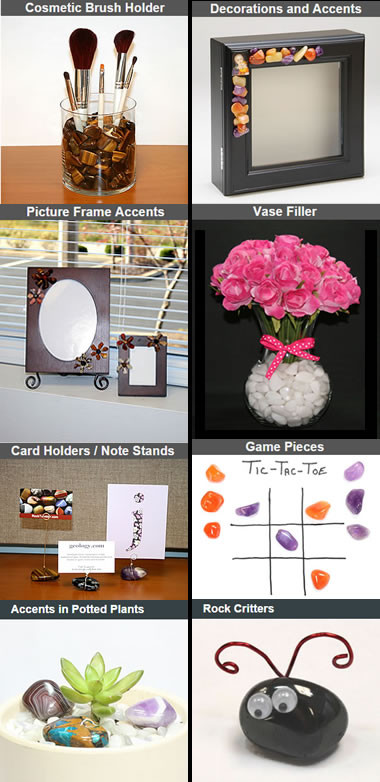Rock tumblers use abrasion to transform rough rocks into polished gems, and you can learn how to master the process with rockscapes.net. This guide explores rotary and vibratory tumblers, grit stages, and selecting the right rocks for a dazzling finish. Discover the art of rock polishing and create stunning tumbled stones, showcasing lapidary, polishing media, and different types of rocks.
1. What Is A Rock Tumbler And What Is It Used For?
A rock tumbler is a machine that smooths and polishes rough rocks and minerals into aesthetically pleasing stones. It is used by hobbyists, jewelers, and artisans to create tumbled stones for jewelry, crafts, and decorative purposes.
Rock tumblers come in different sizes, from small hobbyist models to large commercial machines, but the core principle remains the same: transforming rough, unpolished rocks into smooth, shiny gems. These machines are popular among those who enjoy discovering the hidden beauty within ordinary stones, turning them into eye-catching pieces for various applications.
1.1 What Are The Benefits Of Using A Rock Tumbler?
Using a rock tumbler offers numerous benefits for both hobbyists and professionals:
- Reveals Natural Beauty: Tumbling unveils the vibrant colors and patterns hidden beneath the rough exterior of rocks.
- Creates Smooth Surfaces: Sharp edges are smoothed, making the stones safe to handle and use in jewelry or crafts.
- Cost-Effective: Collecting and tumbling your own stones can be more economical than purchasing polished stones.
- Therapeutic: Many find the process of selecting, tumbling, and polishing rocks to be relaxing and rewarding.
- Educational: Rock tumbling provides a hands-on learning experience about geology and mineralogy.
- Customizable: You have complete control over the final product, allowing you to create unique and personalized stones.
- Versatile: Tumbled stones can be used in jewelry making, home décor, garden accents, and various craft projects.
- Sustainable: It’s an eco-friendly way to repurpose rocks and minerals found in nature.
1.2 What Materials Can Be Polished In A Rock Tumbler?
Many different materials can be polished in a rock tumbler, but the best results are typically achieved with harder stones. According to the Gemological Institute of America (GIA), rocks with a Mohs hardness of 6 or higher are ideal for tumbling. Some of the most popular and effective materials include:
- Agate: Known for its vibrant colors and banding patterns.
- Jasper: Available in a wide variety of colors and patterns, often with unique inclusions.
- Chalcedony: A translucent variety of quartz with a waxy luster.
- Petrified Wood: Fossilized wood that has been replaced by minerals, often with intricate details.
- Amethyst: A purple variety of quartz, prized for its color.
- Rose Quartz: A pink variety of quartz, known for its gentle energy.
- Tiger’s Eye: A chatoyant gemstone with golden-brown hues.
- Obsidian: A volcanic glass with a smooth, reflective surface.
- Aventurine: A variety of quartz with shimmering inclusions.
- Sodalite: A blue mineral often used for ornamental purposes.
Other materials that can be tumbled include:
- Basalt
- Beryl
- Bloodstone
- Carnelian
- Chrysoprase
- Flint
- Fluorite
- Granite
- Hematite
- Labradorite
- Lapis Lazuli
- Malachite
- Rhodochrosite
- Rhodonite
- Smoky Quartz
- Sunstone
- Turquoise
- Unakite
 Tumble-Polished Stones
Tumble-Polished Stones
1.3 Are There Any Safety Precautions To Take When Using A Rock Tumbler?
Yes, safety is paramount when using a rock tumbler. Improper use can lead to accidents or damage to the machine. Here are some essential precautions:
- Wear Safety Glasses: Protect your eyes from grit or rock fragments that may be ejected during the tumbling process.
- Use Gloves: Protect your hands from abrasive grit and prolonged exposure to water.
- Work in a Well-Ventilated Area: Some grit and polishing compounds may produce dust or fumes, so ensure adequate ventilation.
- Keep Away from Children and Pets: Rock tumblers should be kept out of reach of children and pets due to the potential hazards of small parts and electrical components.
- Unplug Before Maintenance: Always unplug the tumbler before cleaning, inspecting, or performing any maintenance.
- Do Not Overload the Barrel: Overloading can damage the motor and reduce the effectiveness of the tumbling process.
- Inspect the Barrel Regularly: Check for cracks, leaks, or wear and tear, and replace the barrel if necessary.
- Use the Correct Grit: Using the wrong grit can damage the rocks or the tumbler.
- Clean the Barrel Thoroughly: Clean the barrel and rocks thoroughly between each grit stage to prevent contamination.
- Monitor the Tumbler: Check the tumbler periodically to ensure it is running smoothly and not overheating.
- Follow Manufacturer’s Instructions: Always adhere to the manufacturer’s guidelines for safe operation and maintenance.
2. How Do Rock Tumblers Work: Understanding The Basics
Rock tumblers work through a process of abrasion, using a rotating barrel and abrasive grit to gradually smooth and polish rocks. The basic components include a motor, a barrel, and various grades of grit.
The motor rotates the barrel, causing the rocks inside to tumble against each other and the abrasive grit. This continuous friction wears down the rough edges and surfaces of the rocks, gradually transforming them into smooth, polished stones. The process typically involves multiple stages, each using a different grade of grit to achieve the desired finish.
2.1 What Is Rotary Rock Tumbling?
Rotary rock tumbling is the most common method, involving a barrel that rotates horizontally on a motorized base. As the barrel turns, the rocks inside tumble against each other along with abrasive grit and water. This constant abrasion gradually smooths the rocks over several stages, each using a finer grit.
Rotary tumblers are known for their simplicity and effectiveness, making them a popular choice for hobbyists and small-scale commercial operations. They can handle a variety of rock types and sizes, and the tumbling process can take several weeks to achieve the desired polish. Rotary tumbling is ideal for achieving a rounded, natural-looking finish on the stones.
2.2 What Is Vibratory Rock Tumbling?
Vibratory rock tumbling uses a vibrating bowl to agitate the rocks, grit, and water. Instead of tumbling, the rocks rub against each other in a high-frequency, circular motion. This method is faster than rotary tumbling, often completing the polishing process in a matter of days.
Vibratory tumblers are particularly effective for polishing delicate or unusually shaped stones, as they minimize the risk of chipping or breakage. They also tend to produce stones with sharper edges and less rounding compared to rotary tumbling. Vibratory tumbling is a great option for those who want to achieve a quick and precise polish on their rocks.
2.3 How Are Rocks Polished Using Rock Tumblers?
Rocks are polished in rock tumblers through a multi-stage process that involves using different grades of abrasive grit. The process typically consists of four stages: coarse grinding, medium grinding, fine grinding, and polishing.
- Stage 1: Coarse Grinding: This initial stage removes the rough edges and shapes the rocks. Coarse grit, typically silicon carbide, is used to aggressively grind the rocks against each other. This stage can last from one to two weeks, depending on the hardness and shape of the rocks.
- Stage 2: Medium Grinding: After the coarse grinding stage, the rocks are cleaned, and medium grit is added to further smooth the surfaces. This stage helps to refine the shapes and remove any remaining imperfections. It usually lasts about a week.
- Stage 3: Fine Grinding: In this stage, the rocks are tumbled with fine grit to prepare them for polishing. This stage smooths the surfaces even further, creating a pre-polish finish. It also lasts about a week.
- Stage 4: Polishing: The final stage involves tumbling the rocks with a polishing compound, such as aluminum oxide, to create a high-gloss shine. This stage can take up to a week and results in beautifully polished stones.
Between each stage, the rocks and the tumbler barrel must be thoroughly cleaned to remove any residual grit. Contamination from coarser grits can scratch the rocks in the later stages, so cleanliness is crucial.
 Rocks: Before and After Tumbling
Rocks: Before and After Tumbling
3. What Are The Different Types Of Rock Tumblers Available?
Rock tumblers come in various types and sizes, each designed for specific purposes. The main types include toy tumblers, hobbyist tumblers, and commercial tumblers.
Each type of tumbler offers different features, capacity, and durability, catering to different levels of rock tumbling enthusiasts. Selecting the right type depends on your budget, the volume of rocks you want to tumble, and the desired quality of the finished stones.
3.1 What Are Toy Rock Tumblers?
Toy rock tumblers are small, inexpensive machines designed for children and beginners. They typically have a plastic body and barrel and are sold as part of a kit that includes rocks, grit, and instructions.
The main advantage of toy tumblers is their low price, making them an accessible entry point into the hobby. However, they have several limitations:
- Small Capacity: Toy tumblers can only tumble a few ounces of small rocks at a time.
- Short Lifespan: The plastic components tend to wear out quickly, resulting in a short lifespan.
- Noisy Operation: The plastic barrel can be quite noisy during operation, which can be disruptive.
- Lower Quality Results: The tumbling process may not be as effective as with higher-quality tumblers, resulting in less polished stones.
Despite these limitations, toy tumblers can be a fun and educational way to introduce children to the world of rock tumbling.
3.2 What Are Hobbyist Rock Tumblers?
Hobbyist rock tumblers are designed for serious enthusiasts who want to produce high-quality tumbled stones. They are typically made with a metal frame and a rubber-lined barrel, which reduces noise and increases durability.
Hobbyist tumblers come in various sizes, with the capacity to tumble between two and ten pounds of rock. They are powered by quality motors designed to operate for years, and many models can be repaired or refurbished with readily available parts. Some popular brands include Thumler’s Tumblers and Lortone, which have been manufacturing tumblers since the 1950s. These tumblers are known for their reliability and long-lasting performance.
 Hobbyist Rock Tumbler
Hobbyist Rock Tumbler
3.3 What Are Commercial Rock Tumblers?
Commercial rock tumblers are large, heavy-duty machines designed for producing tumbled stones on a large scale. They can tumble anywhere from a few dozen to several thousand pounds of rock at a time and are used by businesses that sell tumbled stones.
Commercial tumblers are built to withstand continuous use and are made with durable materials such as steel and heavy-duty motors. They often feature multiple barrels and automated systems for loading, unloading, and grit dispensing. These machines can cost several hundred to many thousands of dollars, reflecting their capacity and durability. Commercial tumblers are an essential investment for businesses in the tumbled stone industry.
 Commercial Rock Tumbler
Commercial Rock Tumbler
4. Essential Components And Accessories For Rock Tumbling
To achieve the best results in rock tumbling, it’s important to use the right components and accessories. These include the tumbler barrel, abrasive grit, polishing compounds, and other helpful tools.
Each component plays a crucial role in the tumbling process, from shaping and smoothing the rocks to creating a high-gloss finish. Investing in high-quality accessories can significantly improve the quality of your tumbled stones and extend the life of your tumbler.
4.1 What Is The Function Of A Tumbler Barrel?
The tumbler barrel is the container in which the rocks, grit, and water are placed during the tumbling process. It is designed to withstand the constant abrasion and rotation of the rocks, and it plays a critical role in shaping and polishing the stones.
Tumbler barrels are typically made of either plastic or rubber. Rubber barrels are generally preferred because they are more durable, quieter, and provide better cushioning for the rocks. The size and shape of the barrel can also affect the tumbling process, with larger barrels allowing for more rocks to be tumbled at once and specially designed barrels promoting better mixing and abrasion. Regular inspection and maintenance of the barrel are essential to ensure its longevity and performance.
4.2 What Types Of Abrasive Grit Are Used In Rock Tumbling?
Abrasive grit is a granular material used to grind and smooth rocks in a tumbler. It comes in various grades, each designed for a specific stage of the tumbling process. The most common types of abrasive grit are:
- Coarse Grit: Used in the first stage to remove rough edges and shape the rocks.
- Medium Grit: Used in the second stage to further smooth the surfaces and refine the shapes.
- Fine Grit: Used in the third stage to prepare the rocks for polishing and create a pre-polish finish.
- Polishing Compound: Used in the final stage to create a high-gloss shine. Common polishing compounds include aluminum oxide, cerium oxide, and tin oxide.
The grit is typically made of silicon carbide, aluminum oxide, or other abrasive materials. The grade of grit is indicated by a number, with lower numbers indicating coarser grit and higher numbers indicating finer grit.
4.3 What Polishing Compounds Are Recommended For Rock Tumbling?
Polishing compounds are essential for achieving a high-gloss finish on tumbled stones. These compounds are typically very fine powders that are used in the final stage of the tumbling process. Some of the most recommended polishing compounds include:
- Aluminum Oxide: A versatile polishing compound that works well on a wide variety of rocks.
- Cerium Oxide: Known for its ability to produce a brilliant shine on glass and harder stones.
- Tin Oxide: A traditional polishing compound that is effective on softer stones.
- Diamond Paste: Used for polishing very hard stones and creating a mirror-like finish.
- Rock Polish: A pre-mixed polishing compound that contains a blend of polishing agents and additives.
When selecting a polishing compound, it’s important to consider the type of rock you are polishing and the desired finish. Some compounds are better suited for certain materials, and experimenting with different compounds may be necessary to achieve the best results.
5. Step-By-Step Guide To Using A Rock Tumbler
Using a rock tumbler can seem daunting at first, but with a step-by-step guide, you can achieve beautifully polished stones. The process involves several stages, each requiring specific materials and techniques.
Following these steps carefully will help you avoid common mistakes and ensure that your rocks are transformed into stunning gems. Whether you’re a beginner or an experienced hobbyist, this guide will provide valuable tips and insights for successful rock tumbling.
5.1 How To Select The Right Rocks For Tumbling?
Selecting the right rocks is crucial for achieving successful tumbling results. Not all rocks are suitable for tumbling, and choosing the wrong ones can lead to disappointment. Here are some tips for selecting the best rocks for your tumbler:
- Hardness: Choose rocks with a Mohs hardness of 6 or higher. Softer rocks may wear away too quickly or not polish properly.
- Texture: Select rocks with a fine-grained, non-porous texture. Porous rocks can absorb grit and polishing compounds, making them difficult to clean.
- Shape: Look for rocks that are relatively smooth and rounded. Angular or fractured rocks may break apart during tumbling.
- Size: Choose rocks that are similar in size. This will ensure that they grind and polish evenly.
- Type: Agate, jasper, chalcedony, and petrified wood are all excellent choices for tumbling.
- Avoid: Avoid rocks with cracks, voids, or inclusions, as these can weaken the stone and cause it to break apart.
5.2 What Is The Process Of Loading A Rock Tumbler?
Loading a rock tumbler correctly is essential for achieving optimal results. Here’s a step-by-step guide:
- Clean the Rocks: Wash the rocks thoroughly to remove any dirt or debris.
- Fill the Barrel: Fill the barrel about two-thirds to three-quarters full with rocks. Avoid overloading, as this can damage the motor and reduce the effectiveness of the tumbling process.
- Add Grit: Add the appropriate amount of grit for the first stage (coarse grit). Follow the manufacturer’s instructions for the correct amount.
- Add Water: Add water until it just covers the rocks. The water should be enough to create a slurry but not so much that it cushions the rocks.
- Check for Leaks: Ensure the barrel is sealed tightly and there are no leaks.
- Start Tumbling: Place the barrel on the tumbler and turn it on.
5.3 How Long Should Each Tumbling Stage Last?
The duration of each tumbling stage can vary depending on the type of rocks, the size of the tumbler, and the desired finish. However, here are some general guidelines:
- Coarse Grinding: 7-14 days. This stage may need to be repeated if the rocks are particularly rough or angular.
- Medium Grinding: 7 days.
- Fine Grinding: 7 days.
- Polishing: 7 days.
It’s important to check the rocks periodically to monitor their progress. If they are not smoothing or polishing as expected, you may need to extend the duration of the stage or adjust the amount of grit.
 Rock Tumbler Crafts
Rock Tumbler Crafts
5.4 What Are The Best Practices For Cleaning Rocks And Equipment Between Stages?
Cleaning rocks and equipment thoroughly between each stage is crucial for preventing contamination and achieving the best results. Here are some best practices:
- Remove the Rocks: Carefully remove the rocks from the tumbler barrel and set them aside.
- Rinse the Rocks: Rinse the rocks thoroughly under running water to remove any residual grit. Use a soft brush to scrub away any stubborn particles.
- Clean the Barrel: Wash the tumbler barrel with soap and water to remove any remaining grit. Use a brush to scrub the inside of the barrel and remove any buildup.
- Rinse the Barrel: Rinse the barrel thoroughly with water to remove any soap residue.
- Inspect the Rocks: Inspect the rocks for any signs of damage or contamination. Discard any rocks that are cracked or broken.
- Dry the Rocks and Barrel: Allow the rocks and barrel to dry completely before proceeding to the next stage.
6. Troubleshooting Common Rock Tumbling Problems
Even with careful preparation and execution, rock tumbling can sometimes present challenges. Troubleshooting common problems can help you achieve the desired results and avoid frustration.
By addressing these issues promptly and effectively, you can ensure that your rocks are transformed into beautifully polished gems. Here are some common problems and their solutions:
6.1 Why Are The Rocks Not Smoothing Properly?
If your rocks are not smoothing properly, several factors could be contributing to the problem:
- Insufficient Grit: Make sure you are using enough grit for the stage. If the grit is too fine or has been used too many times, it may not be effective.
- Incorrect Grit Type: Ensure you are using the correct grit for the stage. Coarse grit is needed for initial shaping, while finer grits are used for smoothing and polishing.
- Overloading the Barrel: Overloading can prevent the rocks from tumbling freely, reducing the effectiveness of the grinding process.
- Hardness Differences: If you are tumbling rocks with different hardness levels, the softer rocks may wear away too quickly, while the harder rocks may not smooth properly.
- Insufficient Time: Some rocks may require longer tumbling times to achieve the desired smoothness.
6.2 What Causes Pitting Or Cracking In Tumbled Stones?
Pitting or cracking in tumbled stones can be caused by several factors:
- Fractured Rocks: Rocks with existing fractures or cracks are more likely to develop pitting or cracking during tumbling.
- Impact Damage: Rocks that are dropped or subjected to sudden impacts can develop fractures that worsen during tumbling.
- Temperature Changes: Sudden temperature changes can cause rocks to expand and contract, leading to cracking.
- Contamination: Contamination from coarser grits can scratch the rocks and create pits.
- Overloading: Overloading the barrel can cause the rocks to collide with excessive force, leading to damage.
6.3 How To Prevent Grit Contamination During Rock Tumbling?
Preventing grit contamination is crucial for achieving a high-quality finish on your tumbled stones. Here are some tips:
- Thorough Cleaning: Clean the rocks and tumbler barrel thoroughly between each stage to remove any residual grit.
- Separate Containers: Use separate containers for storing each grade of grit to prevent cross-contamination.
- Designated Tools: Use designated tools for handling each grade of grit to avoid mixing them.
- Careful Handling: Handle the rocks and grit carefully to avoid spilling or mixing them.
- Clean Work Area: Keep your work area clean and free of debris to prevent contamination.
7. Advanced Techniques For Rock Tumbling Enthusiasts
For those looking to take their rock tumbling skills to the next level, advanced techniques can help achieve even more stunning results. These techniques involve fine-tuning the tumbling process, experimenting with different materials, and incorporating unique finishing touches.
Mastering these advanced techniques can transform ordinary rocks into extraordinary gems, showcasing your creativity and expertise. Here are some advanced techniques to explore:
7.1 What Is The Best Way To Tumble Soft Or Delicate Stones?
Tumbling soft or delicate stones requires a gentle approach to prevent damage. Here are some tips:
- Use a Vibratory Tumbler: Vibratory tumblers are gentler than rotary tumblers and are less likely to damage soft stones.
- Reduce Tumbling Time: Reduce the tumbling time for each stage to minimize abrasion.
- Use Cushioning Media: Add cushioning media, such as plastic pellets or ceramic beads, to protect the stones from impact.
- Choose Softer Grits: Use softer grits, such as aluminum oxide, for grinding and polishing.
- Monitor Progress: Check the rocks frequently to monitor their progress and adjust the tumbling time as needed.
7.2 How To Achieve A High-Gloss Polish On Tumbled Stones?
Achieving a high-gloss polish requires careful attention to detail and the use of specialized polishing compounds. Here are some tips:
- Use a High-Quality Polishing Compound: Choose a polishing compound specifically designed for the type of rock you are polishing.
- Extend Polishing Time: Extend the polishing time to allow the polishing compound to work its magic.
- Use a Burnishing Step: After polishing, burnish the stones by tumbling them with a mild soap and water to remove any residual polishing compound.
- Use a Rock Polish: Consider using a pre-mixed rock polish for a brilliant, long-lasting shine.
- Clean Thoroughly: Ensure the rocks are thoroughly cleaned before the polishing stage to prevent contamination.
7.3 Can You Combine Different Types Of Rocks In One Tumbling Batch?
Combining different types of rocks in one tumbling batch can be tricky, as rocks with varying hardness levels may not polish evenly. However, it is possible if you follow these guidelines:
- Similar Hardness: Choose rocks with similar hardness levels to ensure they grind and polish at the same rate.
- Similar Size: Select rocks that are similar in size to prevent smaller rocks from being damaged by larger ones.
- Monitor Progress: Check the rocks frequently to monitor their progress and adjust the tumbling time as needed.
- Cushioning Media: Use cushioning media to protect the rocks from impact and prevent damage.
- Separate Batches: If possible, it’s best to tumble rocks of different types in separate batches to achieve the best results.
8. Exploring The World Of Rocks And Minerals With Rockscapes.Net
Rockscapes.net is your ultimate resource for discovering the beauty and versatility of rocks and minerals in landscaping and beyond. From selecting the perfect stones for your garden to mastering the art of rock tumbling, we offer a wealth of information and inspiration.
We are committed to providing you with expert guidance, high-quality products, and a community of fellow enthusiasts to share your passion for rocks and minerals. Visit us today and unlock the endless possibilities of the natural world.
8.1 What Types Of Landscaping Rocks Are Available At Rockscapes.Net?
At rockscapes.net, you’ll find a diverse selection of landscaping rocks to enhance your outdoor spaces. Our inventory includes:
- Boulders: Large, imposing rocks that make a statement in any landscape.
- River Rock: Smooth, rounded stones perfect for creating natural-looking water features and pathways.
- Gravel: Small, crushed stones ideal for ground cover, drainage, and pathways.
- Flagstone: Flat, irregular stones used for patios, walkways, and stepping stones.
- Edging Stone: Decorative stones used to define garden beds and pathways.
- Wall Stone: Stackable stones used to create retaining walls and garden borders.
8.2 How Can Rockscapes.Net Help With Landscaping Projects?
Rockscapes.net can assist you with every aspect of your landscaping projects, from design to installation. We offer:
- Expert Advice: Our team of experienced landscapers can provide guidance on selecting the right rocks and designing your landscape.
- High-Quality Products: We source our rocks from reputable quarries to ensure the highest quality and durability.
- Delivery Services: We offer convenient delivery services to your home or job site.
- Installation Services: We can provide professional installation services for your landscaping projects.
- Inspiration: Our website features a gallery of stunning landscape designs to inspire your creativity.
8.3 Where Can You Find More Information And Inspiration On Rock Landscaping?
For more information and inspiration on rock landscaping, visit rockscapes.net. Our website is filled with articles, tips, and stunning photos to help you create the landscape of your dreams. You can also follow us on social media for the latest trends and ideas. Let us help you transform your outdoor spaces into beautiful and functional works of art.
9. Frequently Asked Questions (FAQ) About Rock Tumbling
Have more questions about rock tumbling? Here are some frequently asked questions to help you further understand the process:
These FAQs should provide you with a solid understanding of rock tumbling and help you achieve beautiful, polished stones.
9.1 Can I Use Regular Sand Instead Of Abrasive Grit In A Rock Tumbler?
No, regular sand is not suitable for use in a rock tumbler. Abrasive grit is specifically designed to grind and smooth rocks, while sand is too soft and will not produce the desired results.
9.2 How Often Should I Change The Grit In My Rock Tumbler?
You should change the grit in your rock tumbler every 7-14 days, depending on the stage of the tumbling process and the hardness of the rocks.
9.3 Can I Add More Rocks To The Tumbler Mid-Cycle?
It’s not recommended to add more rocks to the tumbler mid-cycle, as this can disrupt the tumbling process and affect the quality of the finished stones.
9.4 What Do I Do If My Rock Tumbler Stops Working?
If your rock tumbler stops working, check the power cord, motor, and barrel for any signs of damage. If the problem persists, contact the manufacturer or a qualified repair technician.
9.5 How Do I Dispose Of Used Rock Tumbling Grit?
Dispose of used rock tumbling grit responsibly by sealing it in a plastic bag and discarding it in the trash. Avoid pouring grit down the drain, as it can clog pipes.
9.6 Can I Tumble Rocks With Fossils In Them?
Yes, you can tumble rocks with fossils in them, but be extra careful, as fossils can be delicate. Use cushioning media and reduce tumbling times to minimize the risk of damage.
9.7 What Is The Best Way To Store Tumbled Stones?
Store tumbled stones in a cool, dry place away from direct sunlight. You can display them in a glass jar, arrange them in a decorative bowl, or use them in jewelry or craft projects.
9.8 Can I Use A Rock Tumbler To Polish Metal?
Yes, you can use a rock tumbler to polish metal, but you’ll need to use specialized polishing compounds and techniques.
9.9 What Is The Difference Between A Rotary And A Vibratory Rock Tumbler?
A rotary rock tumbler uses a rotating barrel to tumble rocks, while a vibratory rock tumbler uses a vibrating bowl. Vibratory tumblers are faster and gentler than rotary tumblers.
9.10 How Can I Make My Tumbled Stones More Shiny?
To make your tumbled stones more shiny, use a high-quality polishing compound, extend the polishing time, and burnish the stones after polishing.
10. Call To Action
Ready to transform ordinary rocks into dazzling gems? Visit rockscapes.net today to explore our wide selection of rock tumblers, abrasive grits, and polishing compounds. Discover expert tips and inspiration for all your rock tumbling projects, and let us help you unleash the hidden beauty of the natural world.
Don’t miss out on the opportunity to create stunning tumbled stones that will impress your friends and family. Visit rockscapes.net now and start your rock tumbling adventure today! Our address is 1151 S Forest Ave, Tempe, AZ 85281, United States. You can also reach us at +1 (480) 965-9011.